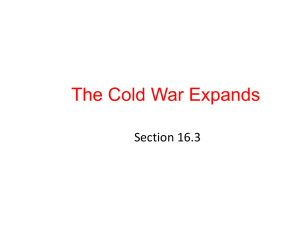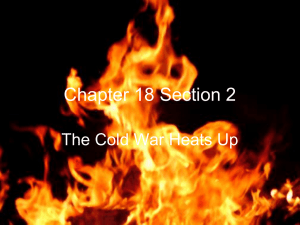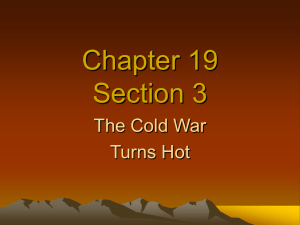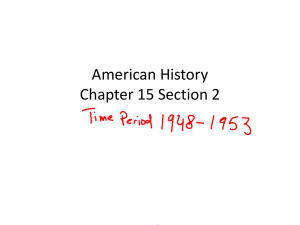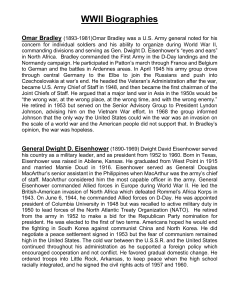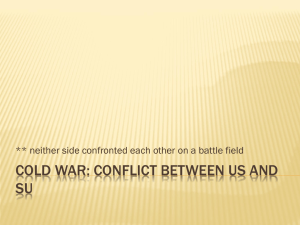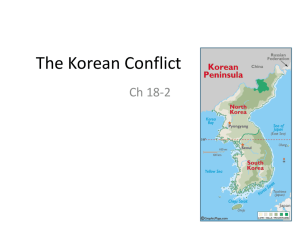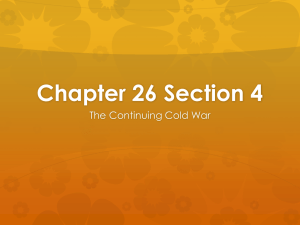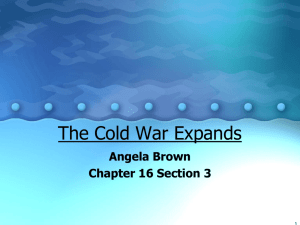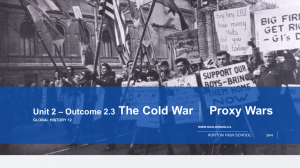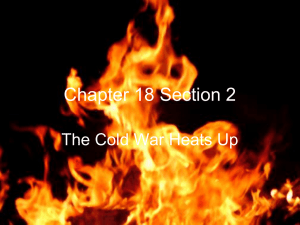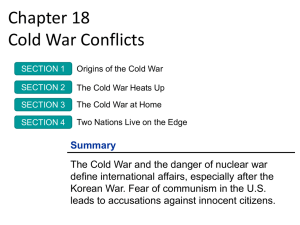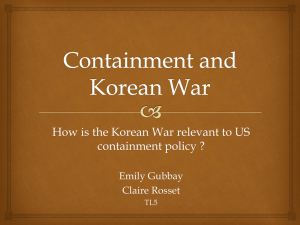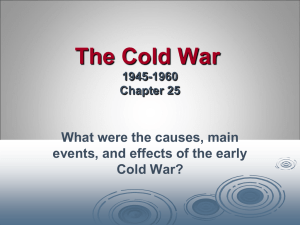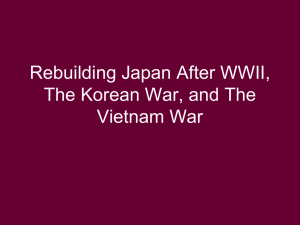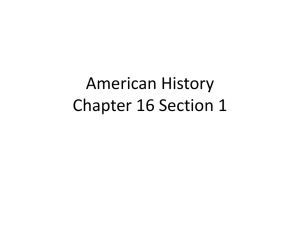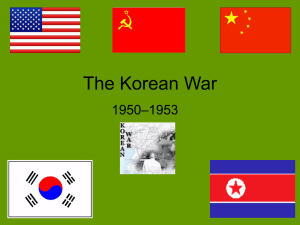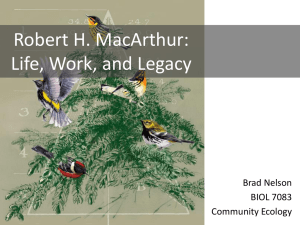Chapter 28 Section 3
advertisement
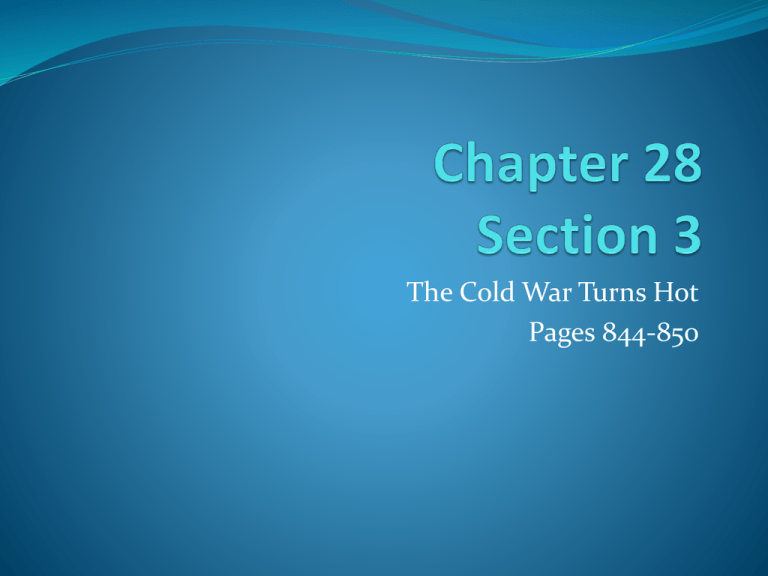
The Cold War Turns Hot Pages 844-850 Section 3 Objectives 1. Explain how the Chinese communists gained control of china. 2. Analyze the factors that led to the escalation of the conflict in Korea. 3. describe the domestic and international effects of the Korean War. 4. Discuss the methods that President Eisenhower used to promote U.S. interests abroad. Question Looking at the countries of North Korea and South Korea consider the reasons for and against U.S. involvement in a war in such a distant place. Communist Victory in China Chiang Kai-shek: The 1920s led to a civil war between the Kuomintang or Nationalist Party up against the Communist Party. During WWII both the Communist and Nationalist parties teamed up together to defeat the Japanese. After the war the Communists promoted themselves for protecting the northeast part of China from the Japanese. Mao Zedong: Communist leader that made reforms that gave land to the peasants. He also increased his military recruitment. United States: didn’t want the expansion of Communism into China. George C. Marshall went to China to arrange a compromise in 1945 neither side would budge. 1949: The Nationalists under Chiang retreated to Taiwan an island off the southeast coast of China. The U.S. didn’t recognize the new government of China known as the People’s Republic of China. The Korean War Begins Japan had ruled over Korea from 1910-1945 when the Soviet and U.S. troops drove them out at the end of WWII. The Allies chose to divide Korea into two zones. Soviets to the north and U.S. to the south. A Divided Korea-This arrangement was to be temporary, but by 1948 each zone had setup individual governments. Kim Il Sung, leader of the Communist North, known as Democratic People’s Republic of Korea. He was in his midthirties when he became premier of North Korea. Guerilla fighter in the 1930s, he opposed the Japanese occupation. Received training in the Soviet Union. Syngman Rhee, Republic of Korea. He was in his seventies when he became president of South Korea. Strong anticommunist and advocate for Korean independence. 30 years of his life was in political exile in the U.S. Bitter Fighting General Douglas MacArthur: U.S. forces were under his command. U.S. 7th Fleet ordered to protect Taiwan. The North Koreans—overran the South Koreans with Soviet weapon power. By September, 1950 the North had nearly all of South Korea. The U.S. and Korea were backed into an area around the port city of Pusan. September 15,1950: MacArthur counterattacks with an invasion into Inch’on and on to recapture Seoul. By late October the North Koreans were pushed back to the Yalu River at around the 38th parallel. November, China’s foreign minister: Jou En-lai-explained why China decided to enter the war on the North Korean side. Outnumbered the U.S. and UN forces backed up to the 38th parallel establishing a defensive line. Ending the Korean War China now involved MacArthur wanted to blockade China’s coast, let Chiang Kai-shek military to invade the mainland, and we would bomb the interior . Debate was high and many were concerned that the Soviets would get involved if China was attacked. Conflict between Truman and MacArthur: President Truman opposed MacArthur plan to attack China. He felt this was a limited conflict and didn’t want another world war. MacArthur criticized the president and appealed to the Congress. MacArthur delivered an ultimatum to the enemy unconditional surrender. This angered Truman would wanted to have peace negotiations. April, 1951-Truman removed MacArthur as commander in Korea. Many people were upset in the U.S. and welcomed MacArthur as a hero. Summer, 1951: War had turned into a stalemate and little territory had changed. The Election of 1952: Truman was confronted with all kinds of issues. He had the Korean War, firing of Douglas MacArthur, and peace talks not moving forward. He decided not to run again for president. Dwight D. Eisenhower: Republican, WWII General and war hero. Richard M. Nixon would be his running mate. Adlai Stevenson: Governor of Illinois will be the Democratic candidate. John Sparkman would be his running mate. The war ends Eisenhower used military force to move peace negotiations forward. 1953 he stepped up the bombing in North Korea and even threatened use of nuclear weapons to end the conflict. July 27, 1953: armistice was negotiated at about the 38th parallel. This was the division before the conflict and many questioned why the human losses. Fighting Communism Abroad During the tenure of the Eisenhower administration the feeling that nuclear arms and technology were important to end the expansion of communism. The policy of Brinkmanship: the threat of massive retaliation –this included the use of nuclear weapons. Secretary of State, John Foster Dulles: called for liberation of communist aggression and don’t back down. Central Intelligence Agency (CIA): Eisenhower was about using covert means and diplomacy. He used the newly formed agency to gather information and pursue Cold War goals. Covert war and the CIA: Supporting the overthrow of the Iranian premier Mohammad Mosaddeq. Pro-American the shah of Iran, Mohammad Reza Pahlavi.. 1954-Guatemala: CIA overthrew Arbenz Guzman for being procommunist. The Suez Crisis: 1956 – U.S. government withdrew an offer to finance a large dam in Egypt. Egypt leader Gamal Abdel Nasser nationalized the Suez Canal. This move could have an impact of western oil trade. In 1956-Israel, Great Britain, and France launched an attack in the Suez area. The Soviets threatened the nations if they didn’t withdraw. Eisenhower Doctrine, 1957: Eisenhower offered military aid to any Middle Eastern nation resisting Communist invasion. Uprising in Eastern Europe Nikita Khrushchev: assumed power in the Soviet Union after the death of Joseph Stalin. The Soviets put down a rebellion in Budapest, Hungary. Eisenhower did not want to invade Eastern Europe due to fear of nuclear war. He did ease on immigration laws to allow for more Eastern Europeans into the United States. Brief Thaw in the Cold War 1959: Vice President Nixon visited the Soviet Union and Khrushchev visited United States. He visited Iowa, Pennsylvania steel mills, and California movie studios. The press loved him and he and Eisenhower agreed to meet in Paris, France the following year to discuss arms reduction. May, 1960: Right before the talks, Khrushchev announced an American U-2 spy plane was shot down over the Soviet Union. The U.S. said it was a weather research plane. The pilot Francis Gary Powers admitted to the spy mission. U-2 incident – decidedly changed the relationship between Khrushchev and Eisenhower. The Soviet leader refused to meet with Eisenhower again even though he promised it wouldn’t happen again. The incident created the Cold War all over again.

